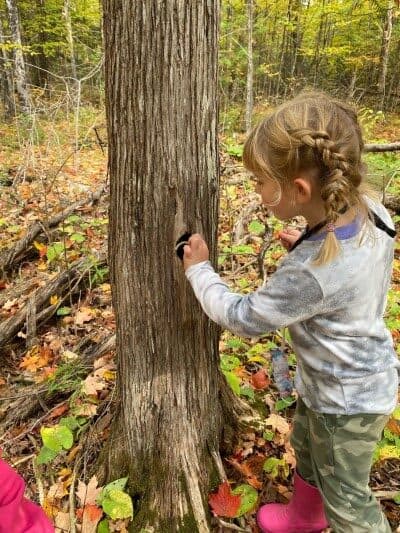Clothespin view (from Discover Your School’s Better Nature)
- During the spring or fall, give your students a clothes pin and have them write their name on it. Clip your clothes pin to a tree bud during spring or clip it to a green leaf during late summer, just as the forests are about to change colour. Visit your clothes pin each day and notice how your bud or leaf transforms. If you can take a photograph of your bud/leaf every day. By focussing on one particular spot we notice the beauty in nature and the effect of seasonal changes.
Seasonal Charades (This activity can also be done post the visit to Camp Kawartha if general class knowledge on seasons is low)
- Bring the students outside if possible
- Initially call out some random things (butterfly, cheese, bike, baby, etc.) and have all the children act out the word, without speaking!
- Number students 1-4
- Then have all the numbers get into groups – secretly tell each group what season (winter, spring, summer, and fall) they need to act out, again without speaking.
- Have the other students guess what their peers are acting out.
- Bring the groups back together, ask them to think what differences they noticed between the seasons’ actions. Share these thoughts with a partner, and then popcorn style big themes as a group.
World Map
- Show where Canada is on the map
- Show the locations of the north pole, south pole and the equator.
- Talk about how seasons change in some places but not others
- Explain how seasons are the opposite of each other in the northern and southern hemispheres and the impact of the equator (light and temperature).
- ** if you have access to a giant floor world map use it to place the children “around the world”
Exploration by taste
- If possible explore different foods by taste, see if the children can find patterns/differences/similarities within what they are tasting
- Explore the different foods that we eat over the course of the year in the region you are in
- Examples: Strawberries in the summer, Squash in the winter, Apples in the fall, and fiddleheads in the spring.
- Why is the summer and fall so bountiful? How can we eat locally right now? What is our area known for?
Squirrel (or bird) Observation(s)
- If possible, observe squirrels outside, it is often relatively evident to see what they are doing.
- In the fall are they stashing food? Getting bigger full of food for the winter?
- In the spring are they collecting materials for nests? Are they smaller than they were in the fall?
Read: Sing in the Spring! by Sheree Fitch, art by Deb Plestid
- Ideally read the book to your class outside.

